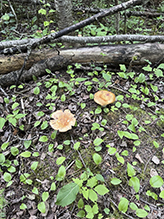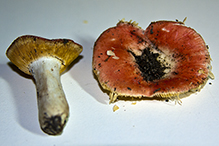Hintapink
(Russula paludosa)
Conservation • Description • Habitat • Ecology • Distribution • Taxonomy
Conservation Status |
|
|||||||
| IUCN Red List | not listed |
|||||||
| NatureServe | not listed |
|||||||
| Minnesota | not listed |
|||||||
Description |
||
Hintapink is a large, brightly colored mushroom. It is found on the ground in mixed woods and coniferous forests from early summer to early autumn. It grows on the roots of pines. The cap is convex when young. As it ages it flattens and sometimes develops a shallow depression at the center. It is bright orangish-red, scarlet, or brownish-red, sometimes with pale areas. It is dull, slimy when wet, and The gills are creamy white at first, turning pale yellowish-orange (ochre) with age. They are fairly closely spaced and are narrowly attached to the stalk. The stalk is white and is sometimes partially or completely flushed with pink. It is smooth, The flesh is firm and white. The taste is mild. Like all Russulas, it is brittle, not fibrous, leading to the common name for this genus, Brittlegill. The spores are pale cream in color. This mushroom is edible but can be easily mistaken for Russula emetica, a poisonous mushroom. |
||
Similar Species |
||
Habitat and Hosts |
||
Mycorrhizal with pines |
||
Ecology |
||
Season |
||
Early summer to early autumn |
||
Distribution |
||||
|
Sources |
|||
| 7/23/2022 | ||||
Occurrence |
||||
Widespread but not uncommon |
||||
Taxonomy |
|||
| Kingdom | Fungi (Fungi) | ||
| Subkingdom | Dikarya | ||
| Phylum | Basidiomycota (Basidiomycete Fungi) | ||
| Subphylum | Agaricomycotina (Higher Basidiomycetes) | ||
| Class | Agaricomycetes (Mushrooms, Bracket Fungi, Puffballs, and Allies) | ||
| Subclass | Agaricomycetidae | ||
| Order | Russulales | ||
| Family | Russulaceae (milkcaps, brittlegills, and allies) | ||
Genus |
Russula (brittlegills) | ||
| Subgenus | Russula | ||
| Subsection | Paludosinae | ||
Synonyms |
|||
|
|||
Common Names |
|||
Bog Russula Hintapink |
|||
Glossary
Mycorrhizal
A symbiotic, usually beneficial relationship between a fungus and the tiny rootlets of a plant, usually a tree.
Visitor Photos |
|||||
Share your photo of this fungus. |
|||||
| This button not working for you? Simply email us at info@MinnesotaSeasons.com. Attach one or more photos and, if you like, a caption. |
|||||
Joshua Smith |
|||||
 |
 |
||||
 |
 |
||||
 |
 |
||||
MinnesotaSeasons.com Photos |
|||||
 |
 |
||||

Slideshows |
||
| Holubinka jahodová - Russula paludosa Jiří Laštůvka - Kudláček |
||
About
Published on Feb 18, 2013 Výskyt červenec až září ve vlhkých jehličnatých lesích, v mechu, borůvčí, vřesu a na rašeliništích, přirozených smrčinách. Upřednostňuje původní bory a borové monokultury kyselé půdy a také horské a podhorské smrčiny. http://kudluvfotoatlashub.blog.cz/1302/holubinka-jahodova-russula-paludosa |
||

Visitor Videos |
|||
Share your video of this mammal. |
|||
| This button not working for you? Simply email us at info@MinnesotaSeasons.com. Attach a video, a YouTube link, or a cloud storage link. |
|||
Other Videos |
|||
| Hintapink (Russula paludosa) | Scientific Mushroom Profile | Shroomers Shroomers |
|||
About
Jun 24, 2022 Russula paludosa was scientifically described by M. Britzelmayr and effectively published in 1891. The name Russula paludosa is of type basionym. For further information, please see M. Britzelmayr (1891) linked below. The scientific classification of Russula paludosa is Fungi, Dikarya, Basidiomycota, Agaricomycotina, Agaricomycetes, Russulales, Russulaceae, Russula. Russula paludosa is also known for its Latin synonyms Russula elatior, Russula integra var. rubrotincta and Russula olgae as well as 3 more synonyms. |
|||
| Holubinka jahodová - Russula paludosa Jiří Laštůvka - Kudláček |
|||
About
Uploaded on Jun 19, 2011 Takto to momentálně vypadá s růstem holubinek. Na sto metrech čtverečních jich včera bylo na stovky. Mám zde zychycené jak jsou rozseté po lese. Z 95% tu je holubinka jahodová, ze 3% h. odbarvená a ze 2% ostatní. |
|||

Last Updated:


